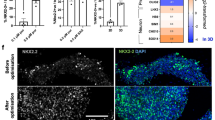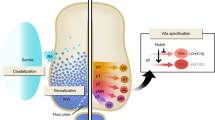Abstract
Cultured spinal motoneurons are a valuable tool for studying the basic mechanisms of axon and dendrite growth and also for analyses of pathomechanisms underlying diseases like amyotrophic lateral sclerosis (ALS) and spinal muscular atrophy (SMA). As motoneurons in the developing spinal cord of mice constitute only a minor population of neurons, these cells need to be enriched in order to study them in the absence of contaminating neuronal and non-neuronal cells. Here, we describe a protocol for the isolation and in vitro cultivation of embryonic primary motoneurons from individual mouse embryos. Tissue dissection, cell isolation and a p75NTR-antibody-based panning technique, which highly enriches motoneurons within <8 h are described. This protocol is aimed to provide an alternative to the established FACS-based protocols describing p75NTR-based enrichments of neurons. This protocol will help in facilitating the research on molecular mechanisms underlying motoneuron development, survival and disease mechanisms.
This is a preview of subscription content, access via your institution
Access options
Subscribe to this journal
Receive 12 print issues and online access
$259.00 per year
only $21.58 per issue
Buy this article
- Purchase on Springer Link
- Instant access to full article PDF
Prices may be subject to local taxes which are calculated during checkout




Similar content being viewed by others
References
Vallstedt, A. et al. Different levels of repressor activity assign redundant and specific roles to Nkx6 genes in motor neuron and interneuron specification. Neuron 31, 743–755 (2001).
Tsuchida, T. et al. Topographic organization of embryonic motor neurons defined by expression of LIM homeobox genes. Cell 79, 957–970 (1994).
Lin, J.H. et al. Functionally related motor neuron pool and muscle sensory afferent subtypes defined by coordinate ETS gene expression. Cell 95, 393–407 (1998).
Johnson, D. et al. Expression and structure of the human NGF receptor. Cell 47, 545–554 (1986).
Ernfors, P., Van De, W.T., Loring, J. & Jaenisch, R. Complementary roles of BDNF and NT-3 in vestibular and auditory development. Neuron 14, 1153–1164 (1995).
Wiese, S., Metzger, F., Holtmann, B. & Sendtner, M. The role of p75NTR in modulating neurotrophin survival effects in developing motoneurons. Eur. J. Neurosci. 11, 1668–1676 (1999).
Camu, W. & Henderson, C.E. Purification of embryonic rat motoneurons by panning on a monoclonal antibody to the low-affinity NGF receptor. J. Neurosci. Methods 44, 59–70 (1992).
Meakin, S.O., Suter, U., Drinkwater, C.C., Welcher, A.A. & Shooter, E.M. The rat trk proto-oncogene product exhibits properties characteristic of the slow nerve growth factor receptor. Proc. Natl. Acad. Sci. USA 89, 2374–2378 (1992).
Wiese, S. et al. Specific function of B-Raf in mediating survival of embryonic motoneurons and sensory neurons. Nat. Neurosci. 4, 137–142 (2001).
Gotz, R. et al. Bag1 is essential for differentiation and survival of hematopoietic and neuronal cells. Nat. Neurosci. 8, 1169–1178 (2005).
Jablonka, S., Beck, M., Lechner, B.D., Mayer, C. & Sendtner, M. Defective Ca2+ channel clustering in axon terminals disturbs excitability in motoneurons in spinal muscular atrophy. J. Cell Biol. 179, 139–149 (2007).
Wiese, S. et al. Adenosine receptor A2A-R contributes to motoneuron survival by transactivating the tyrosine kinase receptor TrkB. Proc. Natl. Acad. Sci. USA 104, 17210–17215 (2007).
Poesen, K. et al. Novel role for vascular endothelial growth factor (VEGF) receptor-1 and its ligand VEGF-B in motor neuron degeneration. J. Neurosci. 28, 10451–10459 (2008).
Rossoll, W. et al. Smn, the spinal muscular atrophy-determining gene product, modulates axon growth and localization of beta-actin mRNA in growth cones of motoneurons. J. Cell Biol. 163, 801–812 (2003).
Rossoll, W. et al. Specific interaction of Smn, the spinal muscular atrophy determining gene product, with hnRNP-R and gry-rbp/hnRNP-Q: a role for Smn in RNA processing in motor axons? Hum. Mol. Genet. 11, 93–105 (2002).
Arakawa, Y., Sendtner, M. & Thoenen, H. Survival effect of ciliary neurotrophic factor (CNTF) on chick embryonic motoneurons in culture: comparison with other neurotrophic factors and cytokines. J. Neurosci. 10, 3507–3515 (1990).
Ford, T., Graham, J. & Rickwood, D. Iodixanol: a nonionic iso-osmotic centrifugation medium for the formation of self-generated gradients. Anal. Biochem. 220, 360–366 (1994).
Bataille, S., Portalier, P., Coulon, P. & Ternaux, J.P. Influence of acetylcholinesterase on embryonic spinal rat motoneurones growth in culture: a quantitative morphometric study. Eur. J. Neurosci. 10, 560–572 (1998).
Schnitzler, A.C., Lopez-Coviella, I. & Blusztajn, J.K. Purification and culture of nerve growth factor receptor (p75)-expressing basal forebrain cholinergic neurons. Nat. Protoc. 3, 34–40 (2008).
Calof, A.L. & Reichardt, L.F. Motoneurons purified by cell sorting respond to two distinct activities in myotube-conditioned medium. Dev. Biol. 106, 194–210 (1984).
Rogers, M.L. et al. Functional monoclonal antibodies to p75 neurotrophin receptor raised in knockout mice. J. Neurosci. Methods 158, 109–120 (2006).
Arce, V. et al. Cardiotrophin-1 requires LIFRbeta to promote survival of mouse motoneurons purified by a novel technique. J. Neurosci. Res. 55, 119–126 (1999).
Bommel, H. et al. Missense mutation in the tubulin-specific chaperone E (Tbce) gene in the mouse mutant progressive motor neuronopathy, a model of human motoneuron disease. J. Cell Biol. 159, 563–569 (2002).
Dohrmann, U., Edgar, D., Sendtner, M. & Thoenen, H. Muscle-derived factors that support survival and promote fiber outgrowth from embryonic chick spinal motor neurons in culture. Dev. Biol. 118, 209–221 (1986).
Acknowledgements
This work was supported by grants from the ACHSE Foundation, the DFG, SFB 581 project B4 and the Herrmann and Lilly Schilling Stiftung and the National Health and Medical Research Council of Australia.
Author information
Authors and Affiliations
Contributions
S.W. initially developed the basic method based on techniques established by M.S. T.H., C.D., S.J. and N.F. established the current protocol, and M.-L.R. and R.R. developed and newly contributed tools (p75NTR-monoclonal antibodies) for this protocol. T.H., C.D. and M.S. prepared the manuscript.
Corresponding author
Ethics declarations
Competing interests
The p75NTR antibodies that we used (MLR2) were originally produced in the laboratory of Robert Rush and Mary-Louise Rogers (coauthors of this paper). The purified antibodies of this hybridoma cultures have been made commercially available through Biosensis, and Robert Rush profited financially from their sale.
Rights and permissions
About this article
Cite this article
Wiese, S., Herrmann, T., Drepper, C. et al. Isolation and enrichment of embryonic mouse motoneurons from the lumbar spinal cord of individual mouse embryos. Nat Protoc 5, 31–38 (2010). https://doi.org/10.1038/nprot.2009.193
Published:
Issue Date:
DOI: https://doi.org/10.1038/nprot.2009.193
This article is cited by
-
Impaired dynamic interaction of axonal endoplasmic reticulum and ribosomes contributes to defective stimulus–response in spinal muscular atrophy
Translational Neurodegeneration (2022)
-
A three-dimensional in vitro model of the peripheral nervous system
NPG Asia Materials (2021)
-
Interaction of 7SK with the Smn complex modulates snRNP production
Nature Communications (2021)
-
Loss of Tdp-43 disrupts the axonal transcriptome of motoneurons accompanied by impaired axonal translation and mitochondria function
Acta Neuropathologica Communications (2020)
-
A video protocol for rapid dissection of mouse dorsal root ganglia from defined spinal levels
BMC Research Notes (2020)
Comments
By submitting a comment you agree to abide by our Terms and Community Guidelines. If you find something abusive or that does not comply with our terms or guidelines please flag it as inappropriate.



